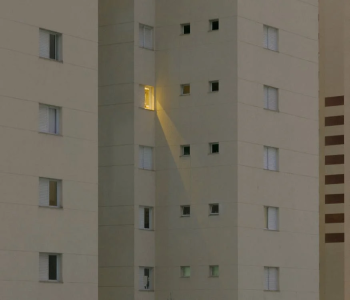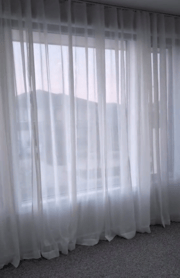The unexpected way to spot draughts that are quietly hiking your energy costs
By
Maan
- Replies 0
A small problem in your home could be quietly driving up your energy bills—and making things far less comfortable than they should be.
What seems like a minor inconvenience is actually a sign of a much bigger issue affecting thousands of households, especially in older properties.
Experts have weighed in on the hidden culprit and what you can do to take back control.
A chill in the air might feel harmless, but when it creeps in under doors or whistles through old windows, it could be costing you more than comfort.
According to experts, draughts were a major issue in older Australian homes, many of which were built long before energy efficiency was a priority.
Michael Ambrose, principal research scientist at the CSIRO, said while new homes had improved over the past decade, older houses continued to leak air by ‘almost any standard in the world’.
‘Our old homes, we haven't done any any extensive studies there on the existing stock, but we know when we talk to people in the in the industry that our old homes are very, very leaky by almost any standard in the world,’ he shared.
‘You only have to talk to people that are living in [older] homes...if you can feel the wind whistling through your home on a windy day, you've got...you've got a very leaky home.’
Stuart Kent, founder of Draught Fix, had the same problem before starting his business.
He sealed his own home first and was shocked by how much of a difference it made.
‘With my house, I did the front door, the back door, the laundry door and around the ceiling area, and it made a huge difference...easily the biggest difference of any energy upgrade I've done, by a long, long stretch,’ he said.
‘So definitely temperature but then it's got all these other benefits as well. Sound is huge; we're not in a super busy area, but wind, weather, passing cars, it made a huge difference to the peace and quiet within the house but it also makes a huge difference with just dust and pollens.’
While draughts made homes colder in winter, Kent noted the benefits carried over into the hotter months too.
Stopping warm air from escaping also meant keeping cool air inside during summer.
Both Ambrose and Kent identified windows and doors as the biggest culprits for draughts.
Floorboards were also a major issue, particularly in older homes where carpet had been ripped up to reveal timber.
‘Particularly when we get an old home what we like to do is rip up all that old carpet and the old lino that was there and polish up those nice floorboards, but there are usually big, big gaps in between those floorboards,’ Ambrose explained.
‘So leakage through the floor because you know the subfloor space is usually not often protected and the wind gets in there and of course it'll whistle through under the home and come up through.’
Ceiling vents, ducting, fireplaces and even power points and cupboards could be unexpected sources of unwanted airflow.
Despite the temptation to hunt down every little leak, Kent advised focusing on areas with the biggest return.
‘It can be a journey of trying to really find all these things and eliminate them as an issue, but I think what I find is doing the high reward stuff makes a huge, huge difference,’ he said.
There was a simple method for locating smaller draughts using nothing more than a candle or incense stick.
‘It's a great way for finding little wisps of a draft around the window or around particular areas that you can then look for ways to fix,’ Kent said.
Ambrose added: ‘It can work in reverse. So if you're running your heating system or your cooling system you can see where the air is escaping your house.’
The smoke would follow the air, revealing its source.
As for how to fix the problem, both experts agreed you didn’t need to spend a fortune.
‘[For doors and windows] lots of DIY things that people can do there by putting door seals, window seals on themselves and even those holes in the walls, if they're ones that are in cupboards [putting] cardboard just over the top to block that hole,’ Ambrose said.
Door snakes remained a tried and true fix, especially for renters.
‘Typically the biggest heat loss is underneath the door so there are numerous store bought more permanent additions that if you owned your own home, you could add, quite cheaply by yourself, just with a few screws,’ Kent explained.
‘As a renter, you might not be able to do that and that's where things like door snakes [come in handy]. You can get ones that have a big kind of roll either side of the door, and then a flat bit that sits underneath the door so it'll even move with the door. You can get a great seal with those and they are something you'd bring out for the winter months.’
Rugs could help block airflow through timber floors, but Ambrose warned they wouldn’t solve the root problem.
‘The subfloor one, those leaky floors, that's a little bit more complicated. Certainly if you've got carpet down and things like if you've got a covering that will act as a barrier so that will help,’ he said.
Fireplaces needed special attention and products like chimney balloons or foam blocks, but safety reminders were critical to avoid accidents.
For those ready to make permanent improvements—or if your home remained unusually draughty—calling in a professional could be worthwhile.
Professionals could install durable seals and assess your home’s overall energy performance.
If you owned your home and were serious about long-term upgrades, expert help might be the most efficient way to go.
In a previous story, we explored simple ways to cut down on your household energy use.
Understanding where your power goes can make a big difference.
Check out the tips to discover which appliances might be driving your bills up.

With energy bills on the rise, how much difference do you think sealing draughts could make in your home? Share your experiences in the comments.
What seems like a minor inconvenience is actually a sign of a much bigger issue affecting thousands of households, especially in older properties.
Experts have weighed in on the hidden culprit and what you can do to take back control.
A chill in the air might feel harmless, but when it creeps in under doors or whistles through old windows, it could be costing you more than comfort.
According to experts, draughts were a major issue in older Australian homes, many of which were built long before energy efficiency was a priority.
Michael Ambrose, principal research scientist at the CSIRO, said while new homes had improved over the past decade, older houses continued to leak air by ‘almost any standard in the world’.
‘Our old homes, we haven't done any any extensive studies there on the existing stock, but we know when we talk to people in the in the industry that our old homes are very, very leaky by almost any standard in the world,’ he shared.
‘You only have to talk to people that are living in [older] homes...if you can feel the wind whistling through your home on a windy day, you've got...you've got a very leaky home.’
Stuart Kent, founder of Draught Fix, had the same problem before starting his business.
He sealed his own home first and was shocked by how much of a difference it made.
‘With my house, I did the front door, the back door, the laundry door and around the ceiling area, and it made a huge difference...easily the biggest difference of any energy upgrade I've done, by a long, long stretch,’ he said.
‘So definitely temperature but then it's got all these other benefits as well. Sound is huge; we're not in a super busy area, but wind, weather, passing cars, it made a huge difference to the peace and quiet within the house but it also makes a huge difference with just dust and pollens.’
While draughts made homes colder in winter, Kent noted the benefits carried over into the hotter months too.
Stopping warm air from escaping also meant keeping cool air inside during summer.
Both Ambrose and Kent identified windows and doors as the biggest culprits for draughts.
Floorboards were also a major issue, particularly in older homes where carpet had been ripped up to reveal timber.
‘Particularly when we get an old home what we like to do is rip up all that old carpet and the old lino that was there and polish up those nice floorboards, but there are usually big, big gaps in between those floorboards,’ Ambrose explained.
‘So leakage through the floor because you know the subfloor space is usually not often protected and the wind gets in there and of course it'll whistle through under the home and come up through.’
Ceiling vents, ducting, fireplaces and even power points and cupboards could be unexpected sources of unwanted airflow.
Despite the temptation to hunt down every little leak, Kent advised focusing on areas with the biggest return.
‘It can be a journey of trying to really find all these things and eliminate them as an issue, but I think what I find is doing the high reward stuff makes a huge, huge difference,’ he said.
There was a simple method for locating smaller draughts using nothing more than a candle or incense stick.
‘It's a great way for finding little wisps of a draft around the window or around particular areas that you can then look for ways to fix,’ Kent said.
Ambrose added: ‘It can work in reverse. So if you're running your heating system or your cooling system you can see where the air is escaping your house.’
The smoke would follow the air, revealing its source.
As for how to fix the problem, both experts agreed you didn’t need to spend a fortune.
‘[For doors and windows] lots of DIY things that people can do there by putting door seals, window seals on themselves and even those holes in the walls, if they're ones that are in cupboards [putting] cardboard just over the top to block that hole,’ Ambrose said.
Door snakes remained a tried and true fix, especially for renters.
‘Typically the biggest heat loss is underneath the door so there are numerous store bought more permanent additions that if you owned your own home, you could add, quite cheaply by yourself, just with a few screws,’ Kent explained.
‘As a renter, you might not be able to do that and that's where things like door snakes [come in handy]. You can get ones that have a big kind of roll either side of the door, and then a flat bit that sits underneath the door so it'll even move with the door. You can get a great seal with those and they are something you'd bring out for the winter months.’
Rugs could help block airflow through timber floors, but Ambrose warned they wouldn’t solve the root problem.
‘The subfloor one, those leaky floors, that's a little bit more complicated. Certainly if you've got carpet down and things like if you've got a covering that will act as a barrier so that will help,’ he said.
Fireplaces needed special attention and products like chimney balloons or foam blocks, but safety reminders were critical to avoid accidents.
For those ready to make permanent improvements—or if your home remained unusually draughty—calling in a professional could be worthwhile.
Professionals could install durable seals and assess your home’s overall energy performance.
If you owned your home and were serious about long-term upgrades, expert help might be the most efficient way to go.
In a previous story, we explored simple ways to cut down on your household energy use.
Understanding where your power goes can make a big difference.
Check out the tips to discover which appliances might be driving your bills up.
Key Takeaways
- Draughts in older Australian homes caused significant energy loss and discomfort, especially through windows, doors, and floorboards.
- Experts like Michael Ambrose and Stuart Kent highlighted how sealing gaps made a noticeable difference in temperature, sound, dust, and overall comfort.
- Simple solutions like door seals, door snakes, and incense tests could identify and fix many issues without major expense.
- For persistent problems or long-term fixes, professionals could install lasting solutions and improve home energy efficiency.
With energy bills on the rise, how much difference do you think sealing draughts could make in your home? Share your experiences in the comments.








